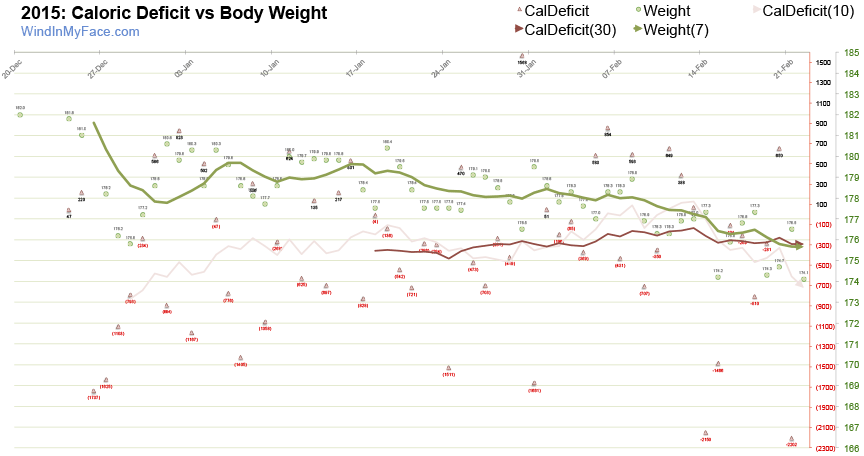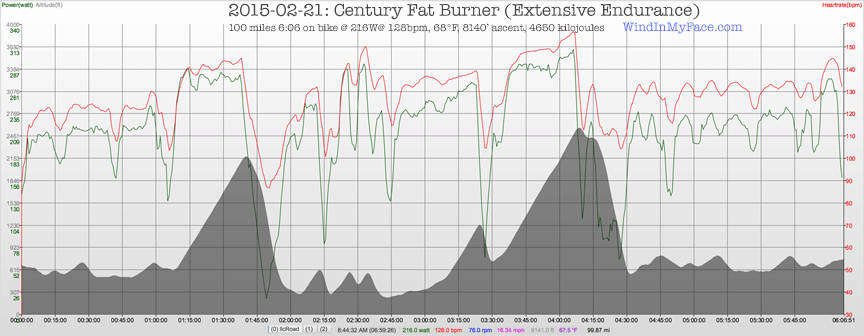Fat Loss vs Weight Loss and Muscle Loss
Legal disclaimer: Since we are not doctors, never follow anything based on health-related or training topics on this or related sites without first consulting with your doctor or other trusted health professional.
Here we distinguish graphing weight daily, with an example. See also the discussion of traditional dieting towards the end of this page.
Weighing in
Weighing in once a week is a naive approach for anyone serious about making steady fat-loss progress: normal variations in morning body weight can exceed the progress made for 2-3 months! This can be discouraging!
Weigh-in every day upon waking (missing a day is no big deal). Graph the weight, looking for lower highs and lower lows. Ignore any particular day; it is the scatterplot from which trends can be seen.
Within one week, there is a meaningful data set; with a weekly weigh-in, there is zero insight (differences are well below the margin of error with a weekly weigh-in).
The scale must have high precision (consistent results for the same weight). The accuracy (true value) is not important to the daily graph.
By graphing weight daily, and utilizing “lower highs and lower lows”, it is possible to see abrupt losses of body mass from a single day effort—an abrupt deflection to the trend. Confirming hard proof is in a series of DEXA scans over time.
Example
In the graph below, observe that were weight were taken once a week, it could appear to be relatively constant at ~177 pounds (depending on which days were weigh-in days). This would be disheartening at best! Yet the trend is clear: by late February, weight is trending towards 174 pounds.
The value of a daily body-weight graph is detecting “lower highs and lower lows”.
Reversals of the trend can also be seen (weight gain). Action can then be taken to forestall unwanted gains.
Over a few weeks, plateaus can also be observed. Sometimes such a plateau is the body’s natural set point, where physiological resistance to further fat losses is high. When observed, special discipline with excercise and diet can be used to smash through the set point, such as by riding a double century. At least if the body fat percentage is not too low already (say 8% or lower). A few more pounds of body fat drop away by so doing (in your author’s own experience).
Discussion continues below. Click for larger graph.

Traditional dieting
Figure 3200 calories (kilocalories) for a pound of body fat (fat is not oil, and has water content too).
Traditional fat loss schemes (appropriate word) mean going hungry every day by 100-300 calories. Agonizingly slowly the fat comes off. After 16 hungry days at 200 calories per day caloric deficit, you’re rewarded by losing a measly pound of body mass—except that it’s probably half a pound of fat and half a pound of muscle—self defeating, since muscle tissue is like an idling motor, constantly consuming fuel (calories). Losing muscle lowers the daily metabolic requirements, the last thing one wants if the goal is to lose body fat (“lose weight”).
- Weight loss is not necessarily fat loss. It often means loss of muscle also. Be clear on the self-defeating cognitive incompetence of the term “weight loss”.
- The type of fat loss matters too; physical activity might well reorganize body fat to brown fat (“good” fat the body uses for energy production) and away from white fat (metabolically semi-inert and hormonally harmful especially around the organs).
See Using DEXA to Assess Progress on Fat/Muscle Changes and Lose a Pound of Fat in ONE Day: Century Fat Burner.
Dieting simply does not work over any longer period of time. The human body and brain are not stupid; physiological adjustments are made to starvation. Moreover, quick weight loss by dieting is a fool’s game: quick losses are generally a loss of glycogen stores,: a pound of glycogen means 3 pounds of water to store it in the body. Only suckers go in for that kind of “weight loss”. Your author sees weight swing of 5-6 pounds from glycogen depletion to full glycogen loading (e.g., before ar race or hard workout).
At much lower cost than Apple, with more options.
Lloyd recommends 64GB for iMac or Mac Pro for photography/videography.
How to lose the fat
See Lose a Pound of Fat in ONE Day: Century Fat Burner.

Data from the SRM power meter (accurate to 1%)




